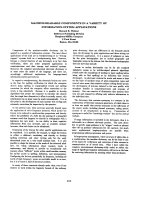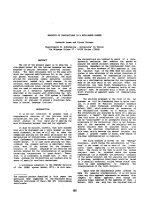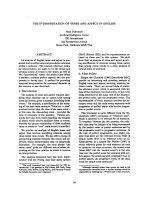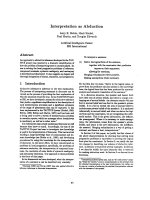Báo cáo khoa học: "ANOTHER SCORE" potx
Bạn đang xem bản rút gọn của tài liệu. Xem và tải ngay bản đầy đủ của tài liệu tại đây (180.38 KB, 2 trang )
2002: ANOTHER SCORE
David G. Hays
Metagram
25 Nagle Avenue, Apartment 3-G
New York, NY 10040
Twenty years is a long time to spend in
prison, but it is a short time in intellectual
history. In the few years Just prior to the
foundation of this Association, we had come from
remarkably complex but nevertheless rather
superficial analysis of text as strings of
characters or, perhaps, lexlcal units to programs
for parsing
that
operated on complex grammatical
symbols but according to rather simple general
principles; the programs could be independent of
the language. And at the moment of foundation, we
had In the words of D. R. Swanson run up against
the stone wall of semantics. No one at the time
could say whether it was the wall of a prison yard
or another step in the old intellectual pyramid.
On my reading, the record is unmistakable.
The best work of the past twenty years has been on
a higher level than that of 1962. Those who
learned about syntactic, semantic, and cognitive
structures as students must feel quite scornful of
the timidity with which we introduced these new
topics to a world that doubted their propriety.
But then some were not so timid. After all, the
new ideas are in the curriculum.
Meanwhile, the commercial significance
of
strings of characters has come to everyone's
attention.
So-called word processors are widely
used, and the market grows. Commercialization of
our most rudimentary techniques has taken twenty
years. We may wonder how long it will take to put
on the market systems with our more recent, more
advanced techniques, but we can be sure
that
the
market will eventually buy them.
We can also be sure of encountering new
barriers. Our most important gain in the past
twenty years is, as I see it, the assurance that
whatever barrier we meet can be climbed. This is
no case of "Climb one, climb them all." Such
arrogance is folly. Language is closely
associated with thought. Knowledge of them both,
and of their association, is Just what carried us
over the barriers that were insurmountable twenty
yea~s ago. The bazrlers we meet are inherent in
the systems of thought
that
we use. We know
enough about thought to announce that its
characteristic and dlsczlminatlng feature is the
capacity to generate new and more powerful systems
of its own kind. A railroad does not become an
elevator when it reaches a cliff, but thought does
Just that.
No one anticipated in 1962 that the study of
language or the investigation of "thinking
machines" would lead in twenty yea~s to an
understanding of how intellectual bazzlers convert
themselves into scaffolding for the erection of
new theoretical systems, and no great social
institution not the university, and certainly not
government has yet recognized the revolutionary
thrust of our small enterprise. The world
understands, vaguely, that great change is taking
place, but who understands that the pace of change
will never slow down?
Intellectual progress consists in the
routinlzatlon of the work of intuitive genius.
Before the Renaissance in Europe, some persons by
insight could establish the sum of two numbers or
the truth of some fact about nature. Since the
Renaissance we take these accomplishments so much
for granted
that
we scarcely understand the system
of thought in which they were problematic. At
most twenty-flve years ago, the determination of
the surface structure of a sentence was
problematic. By now we understand rather clearly
how phonological, syntactic, semantic, and
cognitive considerations interact in parsing.
We, as a global culture, have taken a step
comparable to the Renaissance, and we, as the
members of an Association, have had a significant
role. Advances in linguistics, in cognitive
science, in the
art
of computation, and in
artificial intelligence have contributed to our
work. Some would say
that
we are merely users of
their results. I think that we have supplied a
crucial element, and I understand our name
computational linguistics to designate our
special conceptualization.
Until we went to work, the standard
conceptualization of analysis in western thought
was translation into a universal scheme. Logic,
mathematics, and computation assumed that all
argument would be by manipulation of certain
forms. The logician, mathematician, or
computatlonist was expert in these forms and
manipulations. Given any problem domain, someone
would
translate
its material into the standard
form. After manipulations, someone would
translate the results back.
Computational linguistics has the idea that
computation can be designed on the pattern of
linguistic theory. In this respect, it seems to
me, there is a sharp distinction between
computational linguistics and natural language
processing. The latter seems to belong to
artificial intelligence, and artificial
intelligence seems to be the inheritor of the
standard
assumptions. I think
that
computational
linguistics has
the
advantage.
Language and thought are fantastically
complex, and when their mechanisms are translated
into the old universal forms the representations
95
are equally complex. Yet, from the right
perspective, we have seen that language and
thought have simple structures of their own. If
we translate linguistic mechanisms into
computational terms, the first step is hard, but
the zest is comparatively easy.
The making of software is still, as it has
been from the beginning, a grave problem. For
this problem I see only one remedy. Computational
mechanisms must be translated into the terms of
the user for whom the rest will be easy. But the
user is not unique; the class of users is
heterogeneous. Hence computational mechanisms
must be translated into many different kinds of
terms, and so far this translation seems very
difficult. "Metagramming" is my name for an
approach to the simplification of the hard part.
For thousands or tens of thousands of years
humanity has engaged in the translation of
linguistic mechanisms into the terms of different
perspectives on the world. Thus, cultures and
languages vary in profound ways. And cultures and
languages vary together. Until now no one has
understood this process. It went on In billions
of brains, and it was effective. Now we try to
understand it and to extend it from the linguistic
level to the computational.
The curious formula that we offer for the
conversion of intellectual barriers into
scaffolding is Just this: Formulate a description
of the barrier. Translate the mechanisms of
thought or of computation into the terms of the
description. Execute the new mechanisms. As I
see the matter, such work was done by intuitive
genius until recently, but we ale routinizing it.
This formula generalizes on a central notion of
computational linguistics and seems to me our
first contribution to universal knowledge.
The formula contains an inexplicit element.
What are the terms of the description to be? In
what language does one formulate the description?
I see no plain answer to this question. In fact,
I am willing to take it as identifying, but not as
describing, the next barrier.
Another way to put the matter is to say that
the proper description of the barrier is a
metaphor of its elimination. Metaphor is at
present in the same limelight that illuminated
semantics twenty years ago. We have not yet found
the correct angle to illuminate the problem of
metaphor, the proper language for description of
the problem.
Again, I suggest that metaphors serve us in
discussions of abstract matters. Surmounting an
intellectual barrier is stepping to a higher level
of abstraction or, in a somewhat novel technical
sense, moving to a metalevel.
And finally I point out our inability to
characterize the mutual influence of any complex
whole and its myriad parts. If we consider a play
or novel, a religion, a culture, or a science and
ask how the unique quality of the whole emerges
from the mass of elements, we have little or
nothing of a scientific nature to say. And if we
ask how to construct a system of this kind, how to
design a building or a programming language, how
to enhance a culture or educate a child, we find
ourselves with traditions
and
intuitions but
without explicit theories.
So I see a goal worth scoring, and I imagine
the possibility that computational linguistics can
move toward it. Deep study of computation
inculcates powerful methods of thought, and deep
study of language supplies the right objects of
thought. Computational linguistics contains what
I reckon to be needed by those who would wrestle
with abstraction, metaphor, and metasystems.
Mankind is a complex whole, and its
individual human parts are myriad. The computer
in every home will alter the mutual influence of
person and population. For better or for worse,
no one can yet say. Moral issues arise.
Technical issues will determine not only whether
morally sound principles can be put into practice,
but also how we formulate the moral questions.
Here is work for twenty years to come and beyond.
96









